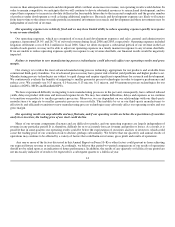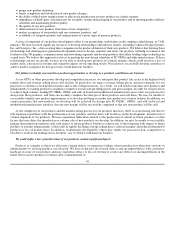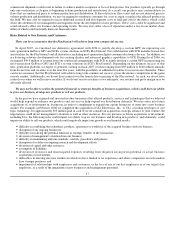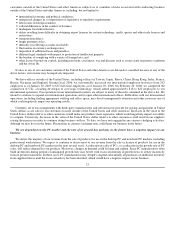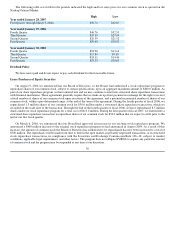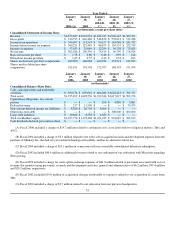NVIDIA 2006 Annual Report Download - page 28
Download and view the complete annual report
Please find page 28 of the 2006 NVIDIA annual report below. You can navigate through the pages in the report by either clicking on the pages listed below, or by using the keyword search tool below to find specific information within the annual report.
If our products do not continue to be accepted by the consumer and enterprise PC, notebook, workstation, PDA, cellular
phone, and video game console markets or if the demand in these markets for new and innovative products decreases, our business
and operating results would suffer.
Our success depends in part upon continued broad adoption of our processors for 3D graphics in consumer and enterprise PC,
notebook, workstation, PDA, cellular phone, and video game console applications. The market for processors has been characterized
by unpredictable and sometimes rapid shifts in the popularity of products, often caused by the publication of competitive industry
benchmark results, changes in pricing of dynamic random−access memory devices and other changes in the total system cost of
add−in boards, as well as by severe price competition and by frequent new technology and product introductions. Only a small
number of products have achieved broad market acceptance and such market acceptance, if achieved, is difficult to sustain due to
intense competition and frequent new technology and product introductions. Since the GPU Business is our core business, our
financial results would suffer if for any reason our current or future GPUs do not continue to achieve widespread acceptance in the PC
market. If we are unable to complete the timely development of products or if we were unable to successfully and cost−effectively
manufacture and deliver products that meet the requirements of the consumer and enterprise PC, notebook, and workstation markets,
we may experience a decrease in revenue which could negatively impact our operating results. Additionally, there can be no assurance
that the industry will continue to demand new products with improved standards, features or performance. If our customers and the
market do not continue to demand new products with increased performance, features, functionality or standards, sales of our products
could decline.
Our failure to comply with any applicable environmental regulations could result in a range of consequences, including fines,
suspension of production, excess inventory, sales limitations, and criminal and civil liabilities.
We may be subject to various state, federal and international laws and regulations governing the environment, including
restricting the presence of certain substances in electronic products and making producers of those products financially responsible for
the collection, treatment, recycling and disposal of those products. For example, the semiconductor industry is moving towards
becoming compliant with the Restriction of Hazardous Substances Directive, or RoHS Directive, which will become effective in July
2006. The RoHS Directive is European legislation that restricts the use of a number of substances, including lead. Similarly, the State
of California has adopted certain restrictions, which go into effect in 2007, that restrict the use of certain materials in electronic
products, that are intended to harmonize with the RoHS directive and other states are contemplating similar legislation. China has
promulgated use restrictions on the same substances as the RoHS directive, but has not yet defined either the scope of the affected
products or an effective date of any such restrictions.
Also, we could face significant costs and liabilities in connection with the Waste Electrical and Electronic Equipment Directive,
or WEEE. The WEEE directs members of the European Union to enact laws, regulations, and administrative provisions to ensure that
producers of electric and electronic equipment are financially responsible for the collection, recycling, treatment and environmentally
responsible disposal of certain products sold into the market after August 15, 2005 and from products in use prior to that date that are
being replaced. We continue to evaluate the impact of specific registration and compliance activities required by WEEE.
It is possible that unanticipated supply shortages, delays or excess non−compliant inventory may occur as a result of such
regulations. Failure to comply with any applicable environmental regulations could result in a range of consequences including fines,
suspension of production, excess inventory, sales limitations, and criminal and civil liabilities.
Hostilities involving the United States and/or terrorist attacks could harm our business.
The financial, political, economic and other uncertainties following the terrorist attacks on the United States in 2001 led to a
weakening of the global economy. Similar terrorist acts and/or the threat of future outbreak or continued escalation of hostilities
involving the United States and Iraq or other countries could adversely affect the growth rate of our revenue and have an adverse
effect on our business, financial condition or results of operations. In addition, any escalation in these events or similar future events
may disrupt our operations or those of our customers, distributors and suppliers, which could also adversely affect our business,
financial condition or results of operations.
22




